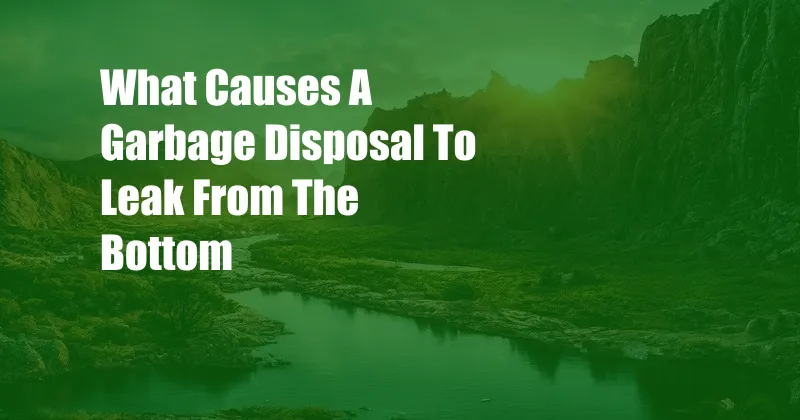
Why is my Garbage Disposal Leaking from the Bottom?
A garbage disposal is an indispensable kitchen appliance that simplifies food waste disposal. However, a leaking garbage disposal can be a frustrating and potentially hazardous issue. If you’re facing this problem, it’s crucial to identify the cause and take prompt action to prevent further damage.
In this comprehensive guide, we’ll explore the various reasons why your garbage disposal may be leaking from the bottom and provide expert advice on how to resolve the issue. We’ll also delve into the latest trends and developments related to garbage disposal maintenance and offer tips from experienced professionals.
Causes of a Leaking Garbage Disposal
There are several potential causes for a garbage disposal leak from the bottom. Here are the most common ones:
1. Loose or Damaged Gasket
The gasket is a rubber seal located between the garbage disposal and the sink flange. It prevents water from leaking when the disposal is in use. Over time, the gasket can become loose, torn, or damaged, leading to leaks.
2. Worn-Out or Damaged Impeller Assembly
The impeller assembly is the component that grinds up food waste. If the impeller or its shaft becomes worn, damaged, or misaligned, it can cause leaks by allowing water to seep through.
3. Clogged Drain Line
If the drain line connected to the garbage disposal is clogged, it can create backpressure that forces water to leak out from the bottom of the disposal.
4. Rust or Corrosion
Garbage disposals are typically made of stainless steel, which is resistant to rust and corrosion. However, over time, even stainless steel can rust due to exposure to moisture or harsh chemicals. Rust or corrosion can weaken the metal and lead to leaks.
5. Faulty Installation
If the garbage disposal was not properly installed, there may be gaps or loose connections that allow water to leak out. It’s crucial to ensure that the disposal is securely mounted and all connections are tightened correctly.
Tips and Expert Advice for Fixing a Leaking Garbage Disposal
If you’re experiencing a leaking garbage disposal from the bottom, here are some tips and expert advice:
1. Check and Replace the Gasket
Inspect the gasket for damage or wear and replace it if necessary. Be sure to use a gasket specifically designed for your garbage disposal model.
2. Inspect and Replace the Impeller Assembly
Remove the impeller assembly and check for any damage or wear. If the impeller or shaft is damaged, replace the entire assembly.
3. Unclog the Drain Line
Run a drain cleaner or use a plumber’s snake to clear any clogs in the drain line. This will help alleviate backpressure and prevent leaks.
4. Inspect for Rust or Corrosion
If you notice any rust or corrosion on the garbage disposal, clean it off thoroughly using a rust-removing solution. If the rust or corrosion is severe, it may be necessary to replace the disposal.
5. Reinstall the Garbage Disposal
If you’ve replaced any components or removed the disposal for inspection, reinstall it carefully. Ensure that all connections are tight and the disposal is securely mounted to the sink.
Frequently Asked Questions (FAQs)
Q: How can I prevent my garbage disposal from leaking in the future?
A: Regular maintenance is key. Clean your garbage disposal with ice and vinegar every few months to remove grease buildup and prevent clogs. Avoid putting hard or fibrous items in the disposal, as they can damage the components.
Q: Is it safe to use a leaking garbage disposal?
A: No. A leaking garbage disposal poses a safety risk as it can lead to electrical shocks or water damage. It’s important to stop using the disposal immediately and address the leak.
Conclusion
A leaking garbage disposal can be a frustrating issue, but it’s usually not difficult to resolve. By understanding the potential causes and following the expert advice outlined in this article, you can effectively fix the leak and restore your garbage disposal to its proper working condition.
Are you interested in learning more about garbage disposal maintenance and troubleshooting? Visit our website for additional resources and tips.